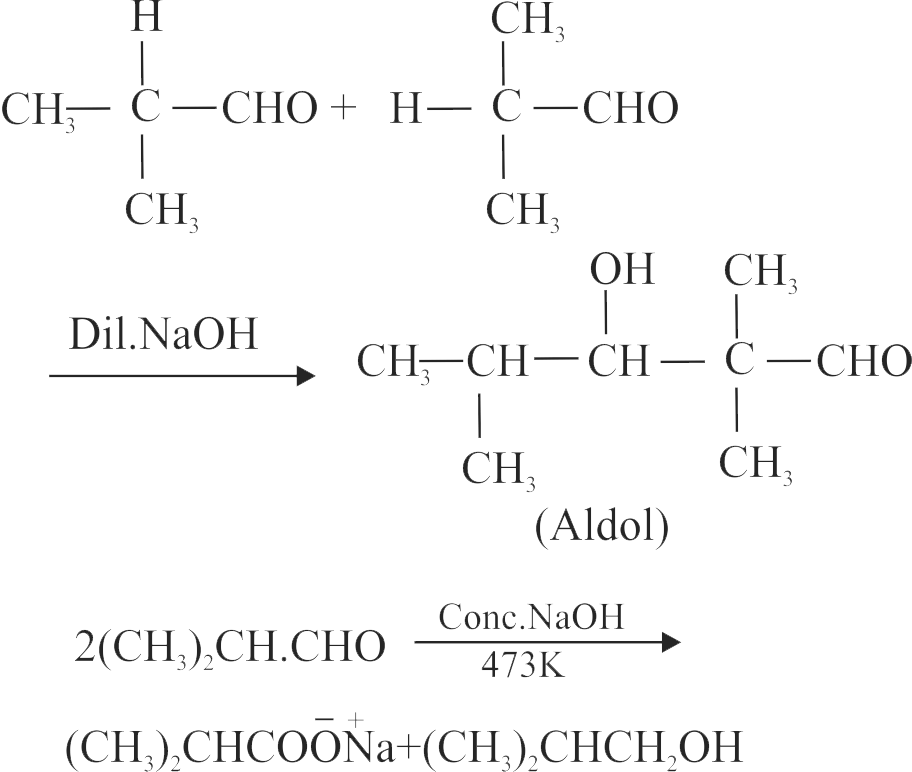323562
\({\rm{Ph - CHO + C}}{{\rm{H}}_{\rm{3}}}{\rm{CHO}}\) \(\xrightarrow[\Delta ]{{{\text{Dil}}{\text{.NaOH}}}}{\text{P}}\)
\({\text{P + }}{{\text{H}}_{\text{2}}}{\text{O}}\xrightarrow{{{{\text{O}}_{\text{3}}}{\text{/Zn - }}{{\text{H}}_{\text{2}}}{\text{O}}}}{\text{Q + Ph - CHO}}\)
Compound 'Q' can undergo which of the
following reaction?
323563
Match List - I with List - II.
List - I List - II
\({\text{R}}{\mkern 1mu} {\text{ - }}{\mkern 1mu} {\text{CH}}{\mkern 1mu} \left( {\text{X}} \right){\text{COOH}}\xrightarrow[{\left( {{\text{ii}}} \right){{\text{H}}_{\text{2}}}{\text{O}}}]{{\left( {\text{i}} \right){{\text{X}}_{\text{2}}}{\text{/Red}}{\mkern 1mu} {\text{P}}}}{\text{R}}{\mkern 1mu} {\text{ - }}{\mkern 1mu} {\text{C}}{{\text{X}}_{\text{2}}}{\text{COOH}}\)
323562
\({\rm{Ph - CHO + C}}{{\rm{H}}_{\rm{3}}}{\rm{CHO}}\) \(\xrightarrow[\Delta ]{{{\text{Dil}}{\text{.NaOH}}}}{\text{P}}\)
\({\text{P + }}{{\text{H}}_{\text{2}}}{\text{O}}\xrightarrow{{{{\text{O}}_{\text{3}}}{\text{/Zn - }}{{\text{H}}_{\text{2}}}{\text{O}}}}{\text{Q + Ph - CHO}}\)
Compound 'Q' can undergo which of the
following reaction?
323563
Match List - I with List - II.
List - I List - II
\({\text{R}}{\mkern 1mu} {\text{ - }}{\mkern 1mu} {\text{CH}}{\mkern 1mu} \left( {\text{X}} \right){\text{COOH}}\xrightarrow[{\left( {{\text{ii}}} \right){{\text{H}}_{\text{2}}}{\text{O}}}]{{\left( {\text{i}} \right){{\text{X}}_{\text{2}}}{\text{/Red}}{\mkern 1mu} {\text{P}}}}{\text{R}}{\mkern 1mu} {\text{ - }}{\mkern 1mu} {\text{C}}{{\text{X}}_{\text{2}}}{\text{COOH}}\)
323562
\({\rm{Ph - CHO + C}}{{\rm{H}}_{\rm{3}}}{\rm{CHO}}\) \(\xrightarrow[\Delta ]{{{\text{Dil}}{\text{.NaOH}}}}{\text{P}}\)
\({\text{P + }}{{\text{H}}_{\text{2}}}{\text{O}}\xrightarrow{{{{\text{O}}_{\text{3}}}{\text{/Zn - }}{{\text{H}}_{\text{2}}}{\text{O}}}}{\text{Q + Ph - CHO}}\)
Compound 'Q' can undergo which of the
following reaction?
323563
Match List - I with List - II.
List - I List - II
\({\text{R}}{\mkern 1mu} {\text{ - }}{\mkern 1mu} {\text{CH}}{\mkern 1mu} \left( {\text{X}} \right){\text{COOH}}\xrightarrow[{\left( {{\text{ii}}} \right){{\text{H}}_{\text{2}}}{\text{O}}}]{{\left( {\text{i}} \right){{\text{X}}_{\text{2}}}{\text{/Red}}{\mkern 1mu} {\text{P}}}}{\text{R}}{\mkern 1mu} {\text{ - }}{\mkern 1mu} {\text{C}}{{\text{X}}_{\text{2}}}{\text{COOH}}\)
323562
\({\rm{Ph - CHO + C}}{{\rm{H}}_{\rm{3}}}{\rm{CHO}}\) \(\xrightarrow[\Delta ]{{{\text{Dil}}{\text{.NaOH}}}}{\text{P}}\)
\({\text{P + }}{{\text{H}}_{\text{2}}}{\text{O}}\xrightarrow{{{{\text{O}}_{\text{3}}}{\text{/Zn - }}{{\text{H}}_{\text{2}}}{\text{O}}}}{\text{Q + Ph - CHO}}\)
Compound 'Q' can undergo which of the
following reaction?
323563
Match List - I with List - II.
List - I List - II
\({\text{R}}{\mkern 1mu} {\text{ - }}{\mkern 1mu} {\text{CH}}{\mkern 1mu} \left( {\text{X}} \right){\text{COOH}}\xrightarrow[{\left( {{\text{ii}}} \right){{\text{H}}_{\text{2}}}{\text{O}}}]{{\left( {\text{i}} \right){{\text{X}}_{\text{2}}}{\text{/Red}}{\mkern 1mu} {\text{P}}}}{\text{R}}{\mkern 1mu} {\text{ - }}{\mkern 1mu} {\text{C}}{{\text{X}}_{\text{2}}}{\text{COOH}}\)



